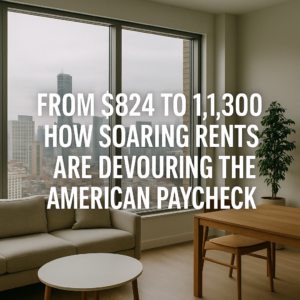
In 2008, the typical monthly rent in the U.S. hovered around $824. Today, it has skyrocketed past $1,300 a historic jump that is reshaping how millions of Americans live, work, and plan their futures.
While inflation, interest rates, and housing supply play major roles in this surge, the human cost is clear: more people are working longer hours just to afford a place to live. According to a new analysis, the average worker must now put in 38.3 hours per month nearly an entire workweek simply to cover their rent.
Rents Are Rising Faster Than Paychecks
Even though wages have increased over the last few years, rent prices have grown even faster. Between 2022 and 2025 alone, rents have surged almost 6%, outpacing wage growth in most sectors.
For many households, this means rent is eating up more than 30% of their income, far exceeding the traditional financial rule of thumb. That leaves less room for savings, emergencies, healthcare, and other essentials.
“Rent affordability has become one of the most pressing economic challenges in the U.S.,” analysts warn. “We’re seeing more workers struggling to keep up, even with full-time employment.”
The True Cost of Rent in Work Hours
To understand the scale of the crisis, consider how many hours a person must work to afford rent in different states:
-
Vermont: 60.2 hours per month
-
Hawaii: 59.9 hours per month
-
California: 52.4 hours per month
-
New Jersey: 50.4 hours per month
-
Maryland: 50.3 hours per month
By contrast, South Dakota stands out with just 27.6 hours per month the lowest in the country.
But the pain is sharpest in major cities. For example, in New York City, a renter must work 90.2 hours each month to afford rent the equivalent of more than two full workweeks. In places like Los Angeles, Boston, and San Francisco, the story is similar: sky-high rents paired with slower wage growth.
A Ray of Hope: Rising Apartment Supply
It’s not all bad news. The U.S. is currently in the middle of an apartment construction boom. This surge in new housing supply is already starting to create small ripples in the rental market.
As developers deliver more units, some landlords are offering concessions, such as free rent for the first month or reduced security deposits. Asking rents have even slipped about 1% year over year as of May a rare break for renters after years of relentless price hikes.
Still, experts caution this is a fragile balance. If construction slows or demand remains high, these gains could disappear quickly.
Renting vs. Buying: The “No Easy Choice” Dilemma
Many might assume that if renting is expensive, buying a home might be the better long-term solution. Unfortunately, that’s not the reality for most Americans today:
-
Mortgage rates are hovering around 7%, pushing monthly payments higher.
-
Home prices have risen roughly 55% since early 2020.
-
High down payments and closing costs remain major barriers for first-time buyers.
In some metro areas, like Austin, Texas, it can actually be cheaper to rent than to buy even as rents rise. This dynamic has locked many households into renting for longer periods, delaying or abandoning homeownership altogether.
The Ripple Effect on American Life
The rent crisis doesn’t just affect monthly budgets it shapes entire life choices:
-
Young adults are delaying moving out, living with family longer to save on housing costs.
-
Families are relocating to cheaper states or rural areas, often leaving behind jobs or support networks.
-
Retirees are increasingly turning to renting as an alternative to buying, especially in high-cost states.
-
Local economies are impacted as renters spend less on non-essential goods and services.
This growing pressure is also feeding political debates around rent stabilization, zoning reform, and affordable housing programs.
Where the Market Might Be Headed
Housing analysts see mixed signals ahead:
-
If supply growth continues, rent hikes may flatten or even slightly decline in certain markets.
-
If interest rates remain elevated, home buying will stay out of reach, keeping pressure on the rental market.
-
Policy shifts around zoning and construction could ease housing shortages over time, but these solutions take years to materialize.
In short, the rent affordability issue won’t vanish overnight. It’s a long-term structural challenge that demands both market adjustments and policy solutions.
Final Takeaway
The jump from $824 to over $1,300 in average U.S. rent is more than just a number it’s a reflection of an economy where housing costs increasingly define financial security.
Renters are working longer hours, cutting back on spending, and struggling to plan for the future. While an apartment construction boom offers hope, it’s not yet enough to close the affordability gap.
Whether you rent or own, housing remains one of the most defining and daunting financial realities in America today.
Source: TradingView – “From $824 to over $1,300: how soaring rents are consuming American paychecks”
